ELLA FITZGERALD & LOUIS ARMSTRONG / “Ella & Louis Mixtape”
This is a superb collaboration. They sing, they swing. It’s a winning combination: Pops, who is often credited with establishing what became the “American” vocal style of performing popular music, and Ella, who is widely lauded as the first lady of jazz vocals. These recordings are over fifty years old, nevertheless they retain a freshness that is astounding, especially when compared to other recordings of similar material from that period.
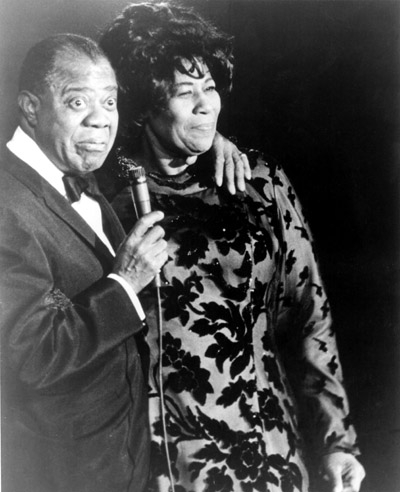 There were actually three albums produced by this duo: Ella and Louis (1956), Ella and Louis Again (1957), Porgy & Bess (1957). All three albums received both critical acclaim and commercial success.
There were actually three albums produced by this duo: Ella and Louis (1956), Ella and Louis Again (1957), Porgy & Bess (1957). All three albums received both critical acclaim and commercial success.
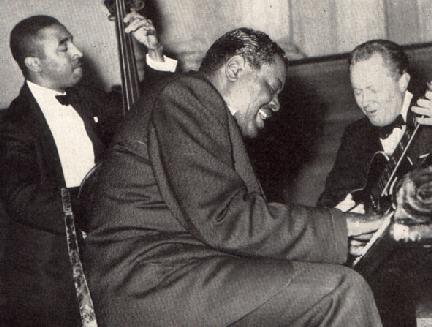 Part of the success is that producer Noman Grantz assembled a stellar cast, employing the Oscar Peterson Quartet [Oscar Peterson – piano, Ray Brown – bass, Herb Ellis – guitar, and Buddy Rich (1956) or Louis Bellson (1957) – drums] to accompany Ella and Pops. This is the epitome of small combo swing jazz.
Part of the success is that producer Noman Grantz assembled a stellar cast, employing the Oscar Peterson Quartet [Oscar Peterson – piano, Ray Brown – bass, Herb Ellis – guitar, and Buddy Rich (1956) or Louis Bellson (1957) – drums] to accompany Ella and Pops. This is the epitome of small combo swing jazz.
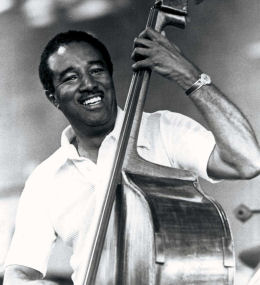 A few observations: Ray Brown’s bass offers one of the fattest harmonic foundations of that era. His impeccable timing and sagacious harmonic note choices and placements make it almost impossible for the soloists not to swing. Note how effective he is at the ballad tempos. One other aspect of Ray Brown’s bass work is that he provides an unprecedented freedom to the lead pianist because no matter what harmonies might be added or implied, Ray Brown is not only right in the pocket, Brown also lightens the load and thus the pianist has more room to literally roam the keyboard adding flourishes, embellishments and alternative voicings.
A few observations: Ray Brown’s bass offers one of the fattest harmonic foundations of that era. His impeccable timing and sagacious harmonic note choices and placements make it almost impossible for the soloists not to swing. Note how effective he is at the ballad tempos. One other aspect of Ray Brown’s bass work is that he provides an unprecedented freedom to the lead pianist because no matter what harmonies might be added or implied, Ray Brown is not only right in the pocket, Brown also lightens the load and thus the pianist has more room to literally roam the keyboard adding flourishes, embellishments and alternative voicings.
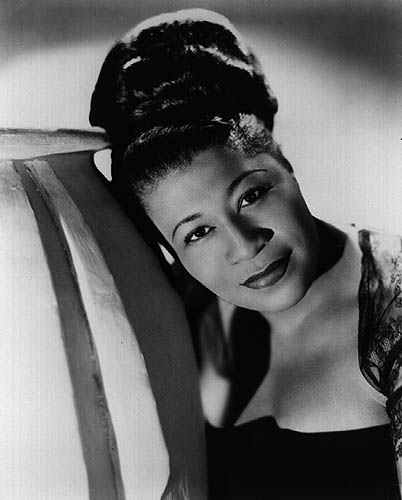 On these tracks, especially the ballads, Ella Fitzgerald sings with the blue-bright brilliance of the Blue Heart diamond. Her tone is so pure and at the same time so agile. Ella excels at both long tones and staccato scats. I really admire her subtle melodic improvisations that utilize her broad range and at the same time are note perfect in both articulation and enunciation. But then, this is why she is considered the first lady of jazz vocals.
Now as for Pops, while his choice of mutes dates much of his trumpet playing, which by the fifties was a long, long ways away from the cutting edge of brass explorations in jazz, his vocal work in contrast is peerless. Although by the early fifties, trumpeter Dizzy Gillespie was the leading voice in jazz as an instrumentalist, we should never forget that Louis Armstrong is the progenitor and that all trumpeters, to one degree or another, are indebted to Pops.
On these tracks, especially the ballads, Ella Fitzgerald sings with the blue-bright brilliance of the Blue Heart diamond. Her tone is so pure and at the same time so agile. Ella excels at both long tones and staccato scats. I really admire her subtle melodic improvisations that utilize her broad range and at the same time are note perfect in both articulation and enunciation. But then, this is why she is considered the first lady of jazz vocals.
Now as for Pops, while his choice of mutes dates much of his trumpet playing, which by the fifties was a long, long ways away from the cutting edge of brass explorations in jazz, his vocal work in contrast is peerless. Although by the early fifties, trumpeter Dizzy Gillespie was the leading voice in jazz as an instrumentalist, we should never forget that Louis Armstrong is the progenitor and that all trumpeters, to one degree or another, are indebted to Pops.
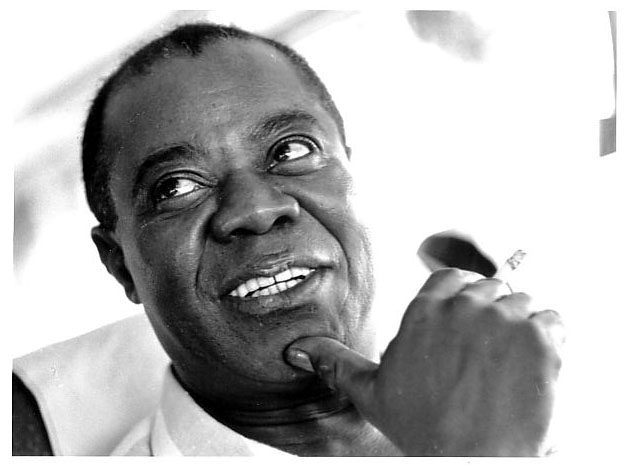 So if the staying power of his work as a trumpeter had diminished, why did he continue to remain a monster as a vocalist—indeed, his biggest vocal hit, “Hello, Dolly,” 1963 was still nearly a decade away. What Pops brought to the music was not vocal gymnastics nor an exquisite instrument in terms of vocal qualities of tone, timbre and overall sonic attractiveness. What distinguished Pops was his sense of rhythmic phrasing, his ability to improvise, and his infectious overall joie de vivre. Listening to Pops made you feel good.
While Pops may not initially strike the ear as the best or most attractive voice, invariably he uplifts your spirits and before you know it, you end up grinning and even attempting to imitate some of his vocal mannerisms—yeeeaaahhh man.
We should not ever minimize this unmatched ability that Pops pioneered. Audiences loved Pops not because he was a clown but rather because he seriously made them feel good, feel fully human, fully alive and thankful to be in the presence of his sonic greatness.
Regardless of what kind of music you might usually enjoy, Ella and Pops will tickle you, bring a smile to your face and cause a significantly upward attitudinal adjustment. You want to feel better? Listen to an hour of Ella and Pops, and you’ll be fine for the balance of your waking hours.
—Kalamu ya Salaam
Ella and Louis Mixtape Playlist
So if the staying power of his work as a trumpeter had diminished, why did he continue to remain a monster as a vocalist—indeed, his biggest vocal hit, “Hello, Dolly,” 1963 was still nearly a decade away. What Pops brought to the music was not vocal gymnastics nor an exquisite instrument in terms of vocal qualities of tone, timbre and overall sonic attractiveness. What distinguished Pops was his sense of rhythmic phrasing, his ability to improvise, and his infectious overall joie de vivre. Listening to Pops made you feel good.
While Pops may not initially strike the ear as the best or most attractive voice, invariably he uplifts your spirits and before you know it, you end up grinning and even attempting to imitate some of his vocal mannerisms—yeeeaaahhh man.
We should not ever minimize this unmatched ability that Pops pioneered. Audiences loved Pops not because he was a clown but rather because he seriously made them feel good, feel fully human, fully alive and thankful to be in the presence of his sonic greatness.
Regardless of what kind of music you might usually enjoy, Ella and Pops will tickle you, bring a smile to your face and cause a significantly upward attitudinal adjustment. You want to feel better? Listen to an hour of Ella and Pops, and you’ll be fine for the balance of your waking hours.
—Kalamu ya Salaam
Ella and Louis Mixtape Playlist
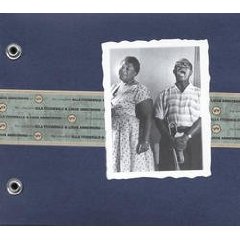 I don’t usually recommend buying box sets except when the box set really offers a significant advantage, by which I mean more than just alternate takes. The Complete Ella Fitzgerald & Louis Armstrong is a box set that is worth getting even if you already own the three albums included in the box. Why? Well, I’m glad you asked.
First, because the box set includes tracks not originally included on the original albums. There are a total of 32 tracks from the two standards albums, which originally include only 11 tracks on the first and 12 tracks on the second. The box set offers 9 more tracks of sublime music. Second, the box set includes liner notes and photos you don’t get on the originals. If you are a collector, it’s worth the investment. If you don’t yet own any Ella & Louis, acquiring the box set is not a choice, it’s a must!
I don’t usually recommend buying box sets except when the box set really offers a significant advantage, by which I mean more than just alternate takes. The Complete Ella Fitzgerald & Louis Armstrong is a box set that is worth getting even if you already own the three albums included in the box. Why? Well, I’m glad you asked.
First, because the box set includes tracks not originally included on the original albums. There are a total of 32 tracks from the two standards albums, which originally include only 11 tracks on the first and 12 tracks on the second. The box set offers 9 more tracks of sublime music. Second, the box set includes liner notes and photos you don’t get on the originals. If you are a collector, it’s worth the investment. If you don’t yet own any Ella & Louis, acquiring the box set is not a choice, it’s a must!
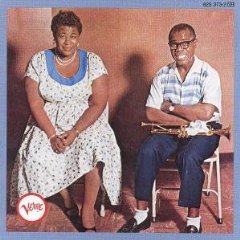 These tracks are from Ella & Louis
01 “Can't We Be Friends”
02 “Moonlight In Vermont”
03 “They Can't Take That Away From Me”
04 “Tenderly”
05 “A Foggy Day”
06 “Cheek To Cheek”
07 “The Nearness of You”
08 “April In Paris”
These tracks are from Ella & Louis
01 “Can't We Be Friends”
02 “Moonlight In Vermont”
03 “They Can't Take That Away From Me”
04 “Tenderly”
05 “A Foggy Day”
06 “Cheek To Cheek”
07 “The Nearness of You”
08 “April In Paris”
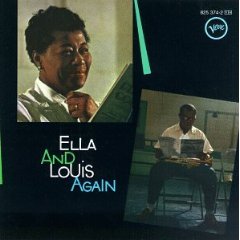 These tracks are from Ella and Louis Again
09 “Autumn In New York”
10 “Stompin' at the Savoy”
11 “Ain't I Good to You”
12 “Forever and a Day”
13 “Learnin' the Blues”
These tracks are from Ella and Louis Again
09 “Autumn In New York”
10 “Stompin' at the Savoy”
11 “Ain't I Good to You”
12 “Forever and a Day”
13 “Learnin' the Blues”
This entry was posted on Monday, August 31st, 2009 at 1:36 am and is filed under Classic. You can follow any responses to this entry through the RSS 2.0 feed. You can leave a response, or trackback from your own site.
Leave a Reply
| top |